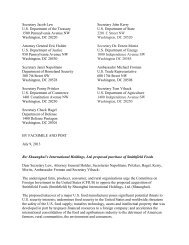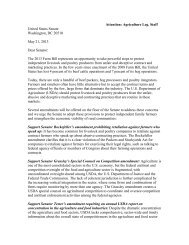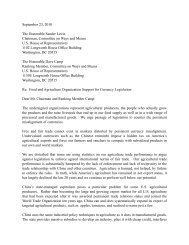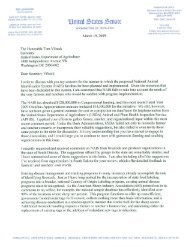Exhibit 8, 100416 Brazil FMD Risk Evaluation - R-Calf
Exhibit 8, 100416 Brazil FMD Risk Evaluation - R-Calf
Exhibit 8, 100416 Brazil FMD Risk Evaluation - R-Calf
Create successful ePaper yourself
Turn your PDF publications into a flip-book with our unique Google optimized e-Paper software.
apparent [28]. Survival of both SVD and ASF viruses in genetic material is possible but is not<br />
considered to be a primary mode of transmission [29, 30].<br />
Based on the extended period of survival of CSF and <strong>FMD</strong> viruses in frozen semen, APHIS<br />
considers the likelihood of exposure of susceptible animals to these viruses in infected semen, if it<br />
were to be imported into the United States, to be high if unmitigated. However, based on the results<br />
of the release assessment, APHIS considers the likelihood of release of CSF or <strong>FMD</strong> viruses via<br />
infected semen from Santa Catarina to be very low. The likelihood of exposure of domestic<br />
livestock would be similarly low.<br />
Consequence Assessment<br />
A consequence assessment describes the biologic and economic consequences of introducing the<br />
hazards under consideration into the United States. This consequence assessment addresses both<br />
direct and indirect consequences, as recommended by the OIE [20].<br />
The magnitude of the biologic and economic consequences following an introduction of <strong>FMD</strong>, CSF,<br />
SVD, or ASF virus would depend on the location of the introduction, the virus serotype introduced,<br />
the rate of virus spread and whether environmental conditions at the introduction site might facilitate<br />
this spread, the site’s ability to detect the disease rapidly, livestock demographics and movement<br />
patterns, and the ease of employing eradication procedures. In addition, depending on the extent of<br />
export of livestock and animal products, trade restrictions imposed by trading partners may result in<br />
severe economic consequences [31].<br />
Direct consequences include effects of the disease on animal health and subsequent production<br />
losses, the total costs of control and eradication, the effect on the environment, and public health<br />
consequences. Indirect consequences include effects on international trade and associated domestic<br />
consequences.<br />
Animal health consequences<br />
<strong>FMD</strong><br />
<strong>FMD</strong> causes significant distress and suffering to animals regardless of the size and sophistication of<br />
their livestock unit. Very high mortality rates in young animals can occur, particularly among pigs<br />
and sheep. Mortality in older animals occurs less frequently but may be significant with certain<br />
virus strains [24, 32, 33].<br />
<strong>FMD</strong> also causes significant losses in the production capacity of affected animals. Productivity<br />
losses of 10 percent to 20 percent are reported in <strong>FMD</strong>-infected livestock if the disease is allowed to<br />
run its course. In addition, <strong>FMD</strong> can cause a reduction in the growth rate of animals raised for meat.<br />
The comparatively greater severity of <strong>FMD</strong> in pigs would imply at least similar losses to those<br />
described for cattle [31, 34].<br />
APHIS <strong>Evaluation</strong> of the Status of the <strong>Brazil</strong>ian State of Santa Catarina 65











